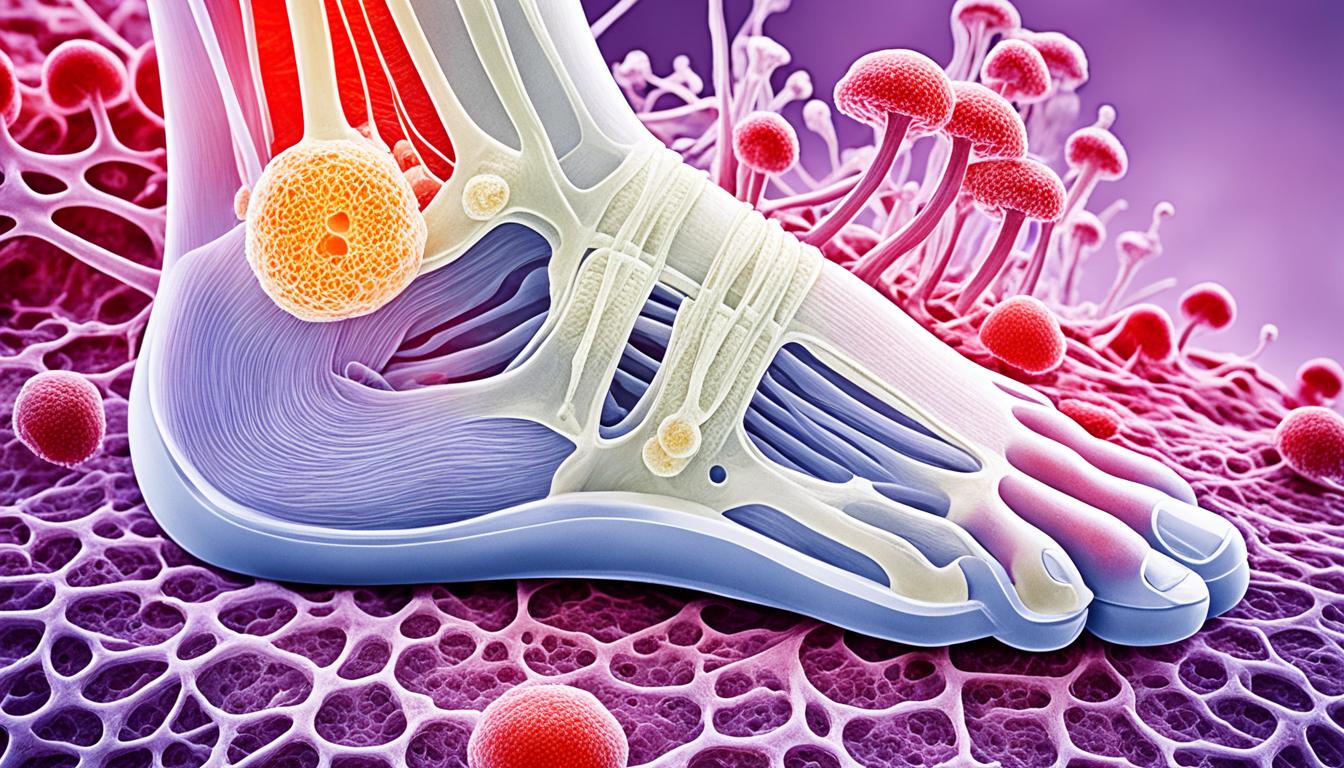Tinea pedis, or athlete’s foot, affects many people. It makes your feet itch and can cause fungal infections on your toes. You might notice these issues more in hot, humid weather like summer. Signs include scaling between your toes, blisters, and cracks. It could also lead to other problems like bacterial infections. If you don’t treat it, it can get worse and become really hard to get rid of.
There are many ways to deal with athlete’s foot. One method being looked at is using stem cells. But, we still need more study to know if this is a reliable treatment.
Key Takeaways:
- Athlete’s foot, or tinea pedis, is a common issue that makes your feet itch and causes toe fungus.
- This problem comes from a superficial fungal infection that’s worse in hot, moist conditions, like summer.
- Starting signs are scaling between the toes, blisters, and cracks. These might also come with bacterial infections and bad smells.
- Without treatment, it can develop into cellulitis or tinea nails, which are harder to treat.
- Stem cell therapy is an option for athlete’s foot, but we need more information on its success.
Symptoms and Diagnosis of Tinea Pedis
Athlete’s foot, or tinea pedis, brings many uncomfortable symptoms. Recognizing these signs early is key. Itchy feet, burning, and blisters are common symptoms. Dryness and changes in toenails can also happen. If you have these signs, see a doctor for a diagnosis.
The doctor will examine your feet closely. They will ask about your symptoms and health history too. Usually, no extra tests are needed for a tinea pedis diagnosis.
Early treatment can stop tinea pedis from spreading. In the next section, we’ll look at what causes it and how to prevent it.
Causes and Prevention of Tinea Pedis
Athlete’s foot, or tinea pedis, is caused by certain fungi. The most common one is Trichophyton rubrum. It likes warm, moist spots, which is why feet can easily get infected.
You can get athlete’s foot by touching someone who has it, or by handling items they touched. Places like pools, locker rooms, and showers are risk areas. So, be careful in these places to avoid getting it.
Preventing athlete’s foot involves some simple steps. Here are important things to do:
- Wash your feet well with soap and warm water. Be sure to clean between your toes.
- After bathing or swimming, make sure your feet are completely dry. Focus on the spaces between your toes.
- Wear socks that let your feet breathe. Natural fibers are best for this reason.
- Pick shoes that keep your feet cool. Shoes that allow air to flow, like sandals, are good choices.
- Don’t share socks, shoes, or towels with anyone to avoid the infection.
- Use antifungal products if your feet sweat a lot, to keep them dry.
- Avoid going barefoot in areas where you might catch the infection from the floor.
- Always clean and protect any cuts or scrapes on your feet.
By taking these steps, you can lower your risk of getting athlete’s foot. But, if you think you have it because your feet are itchy, red, or scaling, see a doctor. They can diagnose and treat the problem.
Treatment Options for Tinea Pedis
Athlete’s foot, or tinea pedis, is often treated with antifungal creams, powders, and sprays. You can find these at the store without a prescription. Using these can help clear up the rash and reduce symptoms. Remember to keep treating your feet even after the rash goes away to avoid it coming back.
Sometimes, oral antifungal drugs are needed for athlete’s foot. This is more likely if the infection is severe or if it reached your nails. These drugs fight the fungus from the inside. Yet, they might cause side effects. So, a doctor should watch how you’re doing and may need to adjust your dosage.
Taking good care of your feet is important for preventing athlete’s foot. Always wash your feet just like you would your hands. Make sure to dry them completely. Using an antifungal powder can keep them dry and stop the fungus from growing. Also, wear clean, dry socks and shoes that let your feet breathe.
If your athlete’s foot turns into onychomycosis, a more serious fungal nail infection, you might need a different treatment. It’s a good idea to see a dermatologist, a skin doctor, for the best advice. They might give you stronger antifungal medicine or suggest a special nail treatment. In rare cases, they might even need to remove the nail.

